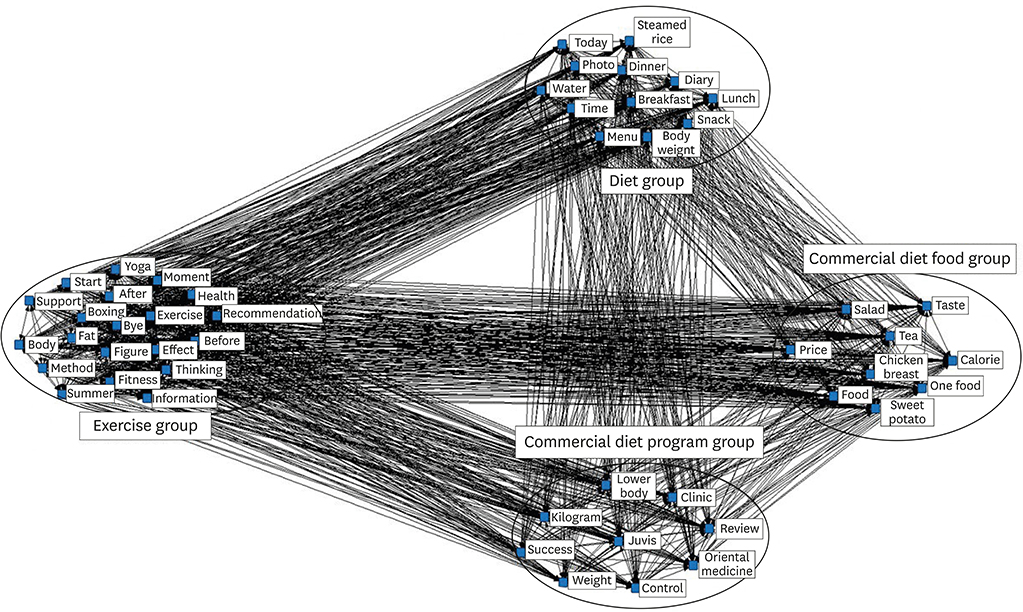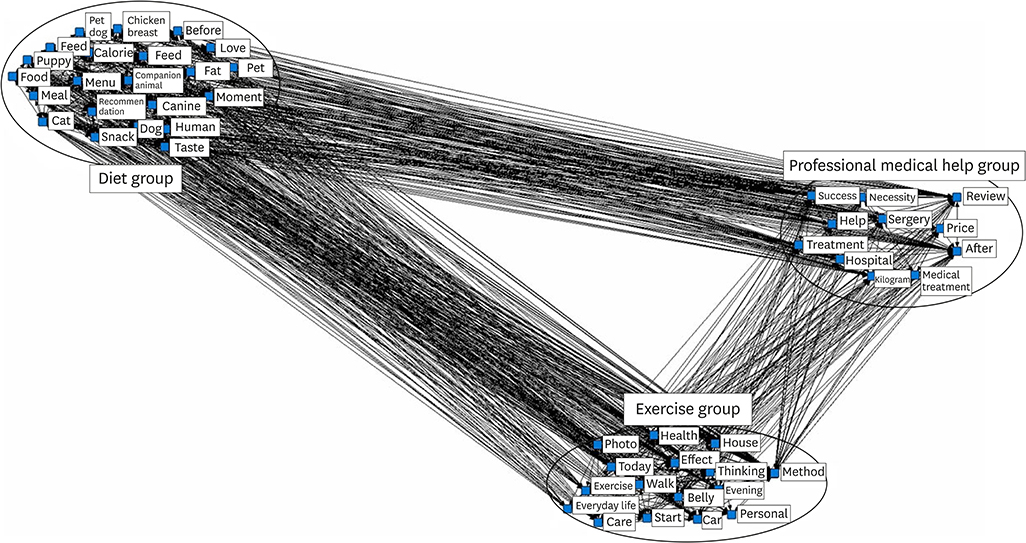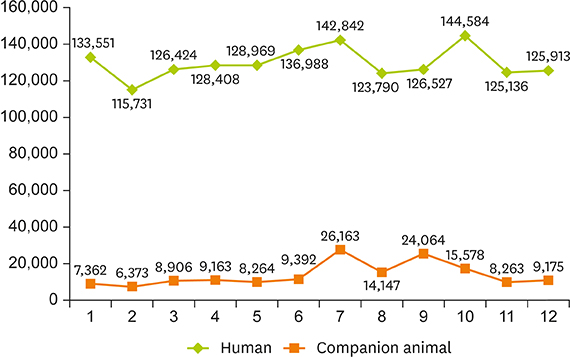Clin Nutr Res.
2017 Oct;6(4):256-266. 10.7762/cnr.2017.6.4.256.
The Analysis of a Diet for the Human Being and the Companion Animal using Big Data in 2016
- Affiliations
-
- 1Department of Food and Nutrition, Dongduk Women's University, Seoul 02748, Korea. uj@dongduk.ac.kr
- 2Department of Food and Nutrition, Ansan University, Ansan 15328, Korea.
- 3Department of Food and Nutrition, Soongeui Women's College, Seoul 04628, Korea.
- 4Department of Family and Consumer Sciences, North Carolina A&T State University, Greensboro, NC 27411, United States.
- KMID: 2392789
- DOI: http://doi.org/10.7762/cnr.2017.6.4.256
Abstract
- The purpose of this study was to investigate the diet tendencies of human and companion animals using big data analysis. The keyword data of human diet and companion animals' diet were collected from the portal site Naver from January 1, 2016 until December 31, 2016 and collected data were analyzed by simple frequency analysis, N-gram analysis, keyword network analysis and seasonality analysis. In terms of human, the word exercise had the highest frequency through simple frequency analysis, whereas diet menu most frequently appeared in the N-gram analysis. companion animals, the term dog had the highest frequency in simple frequency analysis, whereas diet method was most frequent through N-gram analysis. Keyword network analysis for human indicated 4 groups: diet group, exercise group, commercial diet food group, and commercial diet program group. However, the keyword network analysis for companion animals indicated 3 groups: diet group, exercise group, and professional medical help group. The analysis of seasonality showed that the interest in diet for both human and companion animals increased steadily since February of 2016 and reached its peak in July. In conclusion, diets of human and companion animals showed similar tendencies, particularly having higher preference for dietary control over other methods. The diets of companion animals are determined by the choice of their owners as effective diet method for owners are usually applied to the companion animals. Therefore, it is necessary to have empirical demonstration of whether correlation of obesity between human being and the companion animals exist.
Figure
Reference
-
1. Lee KS. A study of diet package for the xers to create proper way of diet: suggesting research and development of pulmuone diet package. Res Bull Package Des. 1998; 5:91–111.2. Maeil Shinmun (KR). The changing times of diet [Internet]. Daegu: Maeil Shinmun;2006. 12. 07. cited 2017 July 21. Available from: http://www.imaeil.com/sub_news/sub_news_view.php?news_id=55059&yy=2006.3. Kim SS. Popular diet-fact and fiction. J Korean Soc Study Obes. 2002; 11:11–18.4. Cho DH. Intermittent fasting in diabetic patients. J Korean Diabetes. 2013; 14:163–165.
Article5. Lee BG, Lee KR, Park MH. Short-term weight management using meal replacements. J Korean Soc Study Obes. 2002; 11:131–141.6. Hong MK. Kimsohyeong diet, cumulative sales exceeded 100 billion [Internet]. Seoul: Inews24;2010. cited 2017 July 21. Available from: http://news.inews24.com/php/news_view.php?g_menu=704110&g_serial=499963.7. Lee DI. When you have high blood pressure and depression, you should not neglect your obesity [Internet]. Seoul: Maeil Business Newspaper;2016. cited 2017 July 21. Available from: http://news.mk.co.kr/newsRead.php?no=427371&year=2016.8. Park SY, Yang SH. A study on the development of pets wear design. J Korean Soc Clothing Ind. 2005; 7:270–276.9. Bae JE, Kim SI. Development of digital contents for abandoned cats: focused on mobile application and character. J Digit Des. 2015; 15:156–164.10. Mun YH, Kim HJ. The effect of companion animals on quality of life of elderly people. J Community Welf. 2011; 37:455–477.11. Choi SY, Seong CH, Hong EJ, Han SW. Effects of animal-assisted activity for Korea elderly with mild cognitive impairment: single subject design. J Soc Occup Ther Aged Dement. 2014; 8:11–19.12. Hwang MC, Kim TS. Pet market trends and prospects: NHERI report 215. Seoul: Nonghyup Economic Research Institute;2013.13. Myung SY, Park SH, Na KU, Kim KJ. A family member ‘petconomy (pet + eco nomy)’ fast growth [Internet]. Seoul: Maeil Business Newspaper;2016. cited 2017 July 21. Available from: http://news.mk.co.kr/newsRead.php?no=802623&year=2016.14. Association for Pet Obesity Prevention. U.S. pets get fatter, owners disagree with veterinarians on nutritional issues [Internet]. [place unknown]: Association for Pet Obesity Prevention;2016. cited 2017 Oct 30. Available from: https://petobesityprevention.org/2016.15. Kang EH. Obesity enemy of pet. With Cap. 2014; 12:42–46.16. Lee OJ, Park SB, Chung DU, You ES. Movie box-office analysis using social big data. J Korea Contents Assoc. 2014; 14:527–538.
Article17. Hwang MG, Choi DJ, Lee HG, Choi C, Ko B, Kim P. Domain n-gram construction and its application. Haksulbalpyononmunjip-Hangukjeongbogwahakhoe. 2010; 37:47–51.18. Narayanan VK, Armstrong DJ. Causal mapping for research in information technology. Hershey (PA): Idea Group Publishing;2005.19. Ahn HJ. Extraction of keywords from brand images texts using network analysis. J Korean Inst Inf Technol. 2012; 10:176–182.20. Moon JY. A study of the intellectual structure of secretarial studies using network analysis. J Secretarial Stud. 2013; 22:125–145.21. Ahn MS, Oh IK. Analysis of attitudes on using five-star hotel packages applying network text analysis method. Korean J Tourism Res. 2015; 30:163–181.22. Wasserman S, Faust K. Social network analysis: methods and applications. Cambridge: Cambridge University Press;1994.23. Jung EJ, Chang UJ. Tendency and network analysis of diet using big data. J Korean Diet Assoc. 2016; 22:310–319.
Article24. Bland IM, Guthrie-Jones A, Taylor RD, Hill J. Dog obesity: owner attitudes and behaviour. Prev Vet Med. 2009; 92:333–340.
Article25. DR Jones LD Lewis . Seal Rock Technologies Incorporated. Weight reduction method for dogs and other pets. United States patent. US 5962043 A. 1999. 10. 05.26. Mozaffarian D, Hao T, Rimm EB, Willett WC, Hu FB. Changes in diet and lifestyle and long-term weight gain in women and men. N Engl J Med. 2011; 364:2392–2404.
Article27. Carciofi AC, Gonçalves KN, Vasconcellos RS, Bazolli RS, Brunetto MA, Prada F. A weight loss protocol and owners participation in the treatment of canine obesity. Cienc Rural. 2005; 35:1331–1338.
Article28. Pack HJ. Various diet methods currently in vogue among the individual. J Korean Soc Study Obes. 2004; 13:470–471.29. Sul MS, Park DY. A prediction of demand for female sport participants by using seasonal ARIMA model. J Korean Phys Edu Assoc Girls Women. 2011; 25:179–192.30. Kim SY. Relationship between eating style and food intake of healthy female college students during chuseok holidays. Korean J Community Nutr. 2016; 21:131–139.
Article31. Lee WR. High calorie Chuseok food becomes extra fat? Chuseok diet method [Internet]. Seoul: Munhwa Ilbo;2016. cited 2017 July 21. Available from: http://www.munhwanews.com/news/articleView.html?idxno=23560.32. Kim J. Effects of a low-carbohydrate, high-fat diet. Korean J Obes. 2016; 25:176–183.
Article
- Full Text Links
- Actions
-
Cited
- CITED
-
- Close
- Share
- Similar articles
-
- Tendency and Network Analysis of Diet Using Big Data
- Comparison and Analysis of Dieting Practices Using Big Data from 2010 and 2015
- Use of cutting-edge RNA-sequencing technology to identify biomarkers and potential therapeutic targets in canine and feline cancers and other diseases
- Comparison of the Center for Children's Foodservice Management in 2012, 2014, and 2016 Using Big Data and Opinion Mining
- Current status and challenges on the big data of public sector in Korea




